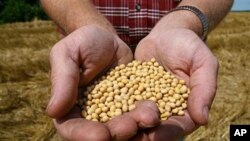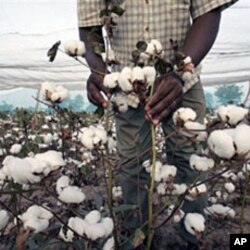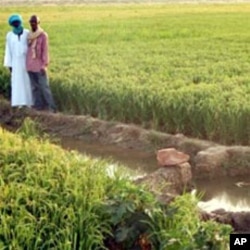For decades, Africa has suffered the ravages of an unpredictable climate, repeating cycles of drought, diminished harvests, hunger and poverty.
Now, proponents of genetic engineering see biotechnology leading the continent to a bountiful and prosperous future by genetically modifying crops to resist drought and pests, and fend off disease.
Margaret Karembu, Director of the International Service for the Acquisition of Agri-Biotech Applications’ AfriCenter (ISAAA) in Nairobi says the benefits of biotechnology are clear in countries like South Africa, which was the first to commercialize biotech (BT) cotton, maize and soybeans in the 1990s, followed by Burkina Faso and Egypt. Other countries like Uganda and Kenya have also begun field test on GM crops.
Karembu says crops like South Africa’s insect-resistant cotton have reduced labor and harmful insecticides, increased yield, and registered farm income gains of about 24 percent.
According to ISAAA, the total crop production gain for soybean, maize, cotton and canola in South Africa was 29.6 million metric tons in 2008.
But Doug Gurian-Sherman, a senior scientist with the Union of Concerned Scientists, an environmental advocacy group in Washington, says available data show that genetic engineering has not enhanced the intrinsic yield of corn and soybeans, and has delivered only minimal operational yields for crops like BT cotton and corn.
| GM Pros | GM Cons | |
|
FAO/genomics.energy.gov
|
Countries with the longest history of GM use, like the U.S., have shown good results with reduced use of insecticides, says Gurian-Sherman. But pests are mutating and developing resistances to the chemicals used in GM crops.
“One of the biggest problems happening in the United States is that weeds are becoming resistant to Roundup herbicide,” said Gurian-Sherman. “And that is causing big problems in cottons and soybeans … and there are parts of the United States where these herbicide-resistant weeds are such a big problem and are so prevalent that farmers can no longer grow cotton in those areas.”
As a result, some U.S. farmers have to use increasingly powerful chemicals to eradicate the weeds. And in both the U.S. and India, cotton is being engineered with different types of biotech genes to stay ahead of the problem.
In parts of China, farmers using less chemical-sprayed insecticide on their BT cotton ran into similar problems.
“[O]ther insect pests that are not controlled by the BT gene started building up a lot,” said Gurian-Sherman. “And so, over a period of 6-7 years, those cotton farmers in China started spraying more and more chemical insecticides so that now they’re spraying about as much chemical insecticide as they were before and [are] having to pay for that.”
That means breeders have to continuously develop new pest-resistant traits. Genetically modifying a plant costs money and can take 10-15 years before the crop enters the market. Once a trait is developed for a particular crop, it can often work with other crops as well.
Gurian-Sherman says developing a trait using biotechnology takes more time and costs between $100-200 million, while conventional agricultural methods cost half that much.
“Is it really worth it to put tens of millions of dollars into developing a single trait that is not very resilient? Biotechnology only solves one problem and only one piece of a problem at a time.”
And in some cases, it creates new ones. There are reports of genetically modified organisms escaping and cross-pollinating native and non-GM plants. While this has provided some farmers with short-term benefits of running into less insects and using less insecticides, the drift appears to be occurring on a much larger scale, at least in the United States.
An August survey by the Ecological Society of America revealed that genetically modified canola has been growing in the wild. According to the study, more than 83 percent of the wild canola surveyed in North Dakota tested positive for GM genes and some tested positive for resistance to Roundup and Liberty insecticides.
That also raises questions about the potential health risks to humans who consume GM crops, although research in this area remains inconclusive.
But Harvard University’s Calestous Juma, Professor of the Practice of International Development at the John F. Kennedy School of Government argues that all technologies carry risks. The challenge, he adds, lies in reducing the risks while maximizing the benefits.
“Not adopting new technologies carries its own risks,” said Juma.
Writing in his book, The New Harvest: Agricultural Innovation in Africa, Juma says African farm incomes and poverty rates were stagnant and in some cases worsened in the past four decades.
“Although 70 percent of Africans are engaged in farming, production is so low that nearly 250 million people, one-quarter of the population, are undernourished,” wrote Juma. “One-third of Sub-Saharan Africans are chronically hungry, while drought, soil degradation and disease appear endemic.”
Juma proposes that biotech seeds could dramatically increase yield and raise incomes.
ISAAA’s Margaret Karembu agrees, saying preliminary studies have shown that in countries like Burkina Faso, farmers are getting benefits of up to 20 percent with biotech agriculture.
She says that does not mean abandoning conventional farming - only using new technologies, not just biotechnology, where appropriate.
Modern, non-GM techniques are already in use in many parts of Africa. One is SRI-Rice, a knowledge-based system focusing on soil improvement with organic matter for better water and nutrient-retention, more spacing between seedlings, and less water in rice paddies, which are traditionally flooded.
“This method,” said Erika Styger, Director of Programs at Cornell University’s System of Rice Intensification Network and Resource Center (SRI-Rice), “only irrigates very, very lightly and lets the water infiltrate. So we can reduce the use of water by almost 30-50 percent. You reduce the fertilizer and the pesticide, and you reduce the amount of seeds.”
The resulting plants are healthier, stronger, and more prolific, increasing the rice yield somewhere between 20-50 percent in places like Madagascar, Mali, Zambia and Ethiopia.
The system costs less, according to Styger and uses fewer resources while changing the way farmers plant their crops.
Studies done by the UN and others show the viability of agro-ecological practices. Gurian-Sherman says farmers don’t have to buy expensive seeds; they just have to develop agriculturally and biologically sound practices that often more than double the yields for small farmers at very little cost.
“It’s not that biotech doesn’t or shouldn’t have a role,” says Gurian-Sherman. “There are a lot of questions that have not been answered about it and it’s a very expensive technology and frankly, doesn’t work as well most of the time as conventional breeding.”
All new technology deserves to be tested, argues ISAAA’s Karembu, and not only in the industrialized world. She says developing countries should be allowed to test them and decide on their own if they are suitable and what safeguards are needed to govern their use.
“Everybody else wants to make decisions for Africa without letting Africans make decisions.”
But she cautions that “biotechnology alone will not solve the problem.” What Africa needs, argues Karembu, is a combination of conventional technologies and the best biotechnologies suited for African soils.













